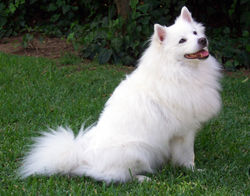|
The American Eskimo Dog
The American Eskimo Dog was formerly called a German Spitz. A breed of companion dog originating in Germany. Due to prejudice during the First World War, it was renamed. Despite its name and appearance the "Eskie" is neither from Alaska nor a descendant of the Husky but rather a member of the Spitz family.
I have owned 2 American Eskimo Dogs, and although this breed is not listed in the top favorites they are definately in my top favorites. My present Eskie "Little bit", is an 11 year old female. An extremely intellegent, loyal and loving family member!
Agile Little Circus DogsThe Eskie achieved a high degree of popularity in the United States as a circus performer in the 1930s and 1940s. One of many American Eskimo Dogs to walk a tightrope was an American Eskimo Dog by the name of Stout's Pal Pierre in the Barnum & Bailey Circus. Stout's Pal Pierre was from a long line of American Eskimos used in Barnum and Bailey's Circus acts. Pierre's grandfather was the first known dog in the world to walk a tight rope. The breed became popular as circuses would sell the puppies during their travels across the nation. We moved from a farm to the city with block walls around our back yard, my Eskie "Snowball" (long since past away) would jump up on this wall and walk the entire length of it. She never jumped over to escape (although we knew she could), she just wanted to see what was out there I guess! Learn more about the "Eskie" here.
Kennel Club RecognitionThe American Kennel Club recognized the breed in 1994 and set the current standard for the breed. This breed was accepted into the Canadian Kennel Club as of March 2006.
Standards SetStandard Height: 38 cm/14-19 inches AppearanceThe American Eskimo Dog as with all Spitzen breeds, have erect, triangular ears, a tail that flips onto its back in a spiral, and two coats of fur: an undercoat that is softer and helps insulate the dog, and an outer coat that's harsher and acts as a weather repellent The coat is thicker and longer around the neck and chest forming a lion-like ruff, more noticeable on dogs than on bitches. The rump and hind legs down to the hocks are also covered with thicker, longer hair. The richly plumed tail is carried loosely on the back.
GroomingDue to their long, dense coat Eskies need regular grooming. Brushing them once a week, or more often is necessary. They shed, but it can be maintained with regular brushing. They shed their coats twice a year, in May or June to shed their winter undercoat and once in November or December to shed their summer coat. Many owners use an undercoat rake, a tool available at most pet stores, for grooming. I have personally found this tool to be invaluable! Although Eskies prefer cold weather, ("mine will go outdoors and roll and play in the snow for hours") they can live in hotter climates as well. They shouldn't be shaved, as the long fur helps to maintain the temperature of their skin. Eskies have drier skin and because of this they need only be bathed every two or three months, unless they soil their coat with large amounts of dirt or substances with strong odors. I Dry Bathe "Little Bit" often, we moved back to our farm and she loves to roll (if you get the picture). Regular brushing maintains a clean coat in most cases. Eskies are a very clean breed and constantly groom themselves.
Return from American Eskimo Dog to Choosing a Dog
|





